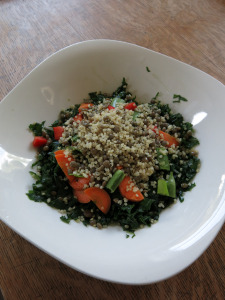Ah, January. The time of new year’s resolutions. One common resolution I’ve been hearing a lot lately is, “This year I’m going to plan my meals!”
Food waste is a big environmental issue.
According to a recent study, $27 billion of Canadian food is wasted every year. $27 billion! This represents farming inputs that didn’t have to be used, food miles that didn’t need to happen, and energy for refrigeration that could have been saved. Of that $27 billion, over 50% of food waste occurs at the household level. So, while retailers and processors have to do their part to reduce waste, we should as well.
Besides, planning meals can save you money. Food can be expensive – especially if it doesn’t get eaten and ends up as a science project in the back of the fridge. Planning meals can save you time – preventing those minutes staring longingly into the fridge, willing dinner to cook itself. And, it can save your relationships, if you are the type that gets cranky when hungry. (Not that I speak from experience….) It’s also a great way to incorporate local foods into your diet, because you actually have a plan for using them.
Here are a few of my tips for meal planning:

Step 1: What do you like to cook?
Make a list of household favourites. Ensure you have a good mix of meals – some that are quick to prepare, some that take a little longer, as well as a mix of breakfast, lunch and dinner foods, main dishes and sides. I like to have a few old stand-bys with ingredients that can easily be substituted. For example, most of my curry recipes can use almost any combination of vegetables, as well as beef or chicken or chickpeas. Depending on how often you like to eat the same thing, you should have about 12 to 20 items on this list. Here are some examples from my house:
- Curry (various types)
- Chili with rice
- Kale salad
- Quinoa salad with roasted vegetables and tahini dressing
- Hamburgers
- Sweet and Sour Fish
You may want to incorporate some new recipes in here too. What have to been wanting to try, but haven’t yet gotten around to?
Step 2: What does your week look like? How to you like to eat?
At my house, dinner is when we do bulk of our cooking. Before planning meals, I look at our schedule for the week. Do we have evening meetings, rehearsals or other commitments? Which nights do we have time to cook and which nights are we going to have to make something fast? I also prepare enough at dinnertime to have enough for leftovers for lunch the next day. In our house, breakfast is generally one of three things: oatmeal, yogurt with granola, or rice with veggies and eggs. I don’t tend to plan breakfast. I just keep the necessary ingredients in the house.
Step 3: What’s in the fridge, freezer or pantry that has to be used up?
This is your time to peruse your kitchen. Wilted lettuce? Milk two days from expiry? Lima beans in the back of the cupboard that won’t go bad but have been there way too long? What do you need to use up?
Step 4:
Sunday: Roasted Squash & Broccoli with Miso dressing on rice
Monday: Sweet and Sour Fish or French Lentils with Roasted Veggies
Tuesday: Out (Friend’s birthday dinner)
Wednesday: Sweet and Sour Fish or French Lentils with Roasted Veggies
Thursday: Pierogies
Friday: ?
Snacks: Hummus & carrot sticks, chia pudding
Step 5:
Make a grocery list and pick up anything you might be out of. Also, if you have to defrost meat, jot down a reminder to take it out of the freezer the day before.
Step 6:
Be flexible. It’s going to shift. I like to have at least one or two back-up meals, for which I always have ingredients and can make in 20 minutes. At our house, this is often spaghetti. I don’t bother to plan to make spaghetti. It just happens. For example, last week we had great intentions of making pierogies on Thursday. This made perfect sense on Sunday morning, but by the time Thursday rolled around, we were tired, we were missing some essential ingredients, and it just wasn’t going to happen. Hence, the back-up plan.
I also like to leave space for last minute inspiration. On Friday, you’ll notice a question mark. We ended up deciding on Friday morning to make Moroccan Stew with couscous and sausage for dinner. We had leftover tomato paste from the Sweet & Sour Fish, lots of root vegetables in the root cellar and picked up some Moroccan sausage at the butcher shop on the way home from work.
Though this list of steps looks rather long when it’s typed out, planning my meals only takes about 20 minutes a week and definitely saves time in the long run.
Some other tips:
- When you’re putting leftovers away in the fridge, divide them up into lunch sized portions so they are ready to go in the morning.
- Keep a notepad on your fridge or a list on your phone of grocery items. When you run out of something or notice that you will soon, add it to the list.
- Need ideas for stocking your pantry with basics? Check out this blog post on a well-stocked pantry.
Happy New Year!
Marla